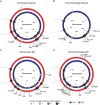Phage selection drives resistance-virulence trade-offs in Ralstonia solanacearum plant-pathogenic bacterium irrespective of the growth temperature
- PMID: 38525025
- PMCID: PMC10959482
- DOI: 10.1093/evlett/qrad056
Phage selection drives resistance-virulence trade-offs in Ralstonia solanacearum plant-pathogenic bacterium irrespective of the growth temperature
Abstract
While temperature has been shown to affect the survival and growth of bacteria and their phage parasites, it is unclear if trade-offs between phage resistance and other bacterial traits depend on the temperature. Here, we experimentally compared the evolution of phage resistance-virulence trade-offs and underlying molecular mechanisms in phytopathogenic Ralstonia solanacearum bacterium at 25 °C and 35 °C temperature environments. We found that while phages reduced R. solanacearum densities relatively more at 25 °C, no difference in the final level of phage resistance was observed between temperature treatments. Instead, small colony variants (SCVs) with increased growth rate and mutations in the quorum-sensing (QS) signaling receptor gene, phcS, evolved in both temperature treatments. Interestingly, SCVs were also phage-resistant and reached higher frequencies in the presence of phages. Evolving phage resistance was costly, resulting in reduced carrying capacity, biofilm formation, and virulence in planta, possibly due to loss of QS-mediated expression of key virulence genes. We also observed mucoid phage-resistant colonies that showed loss of virulence and reduced twitching motility likely due to parallel mutations in prepilin peptidase gene, pilD. Moreover, phage-resistant SCVs from 35 °C-phage treatment had parallel mutations in type II secretion system (T2SS) genes (gspE and gspF). Adsorption assays confirmed the role of pilD as a phage receptor, while no loss of adsorption was found with phcS or T2SS mutants, indicative of other downstream phage resistance mechanisms. Additional transcriptomic analysis revealed upregulation of CBASS and type I restriction-modification phage defense systems in response to phage exposure, which coincided with reduced expression of motility and virulence-associated genes, including pilD and type II and III secretion systems. Together, these results suggest that while phage resistance-virulence trade-offs are not affected by the growth temperature, they could be mediated through both pre- and postinfection phage resistance mechanisms.
Keywords: experimental evolution; phage defense systems; phage resistance; small colony variant (SCV); trade-offs; virulence.
© The Author(s) 2023. Published by Oxford University Press on behalf of The Society for the Study of Evolution (SSE) and European Society for Evolutionary Biology (ESEN).
Figures




Similar articles
-
In through the Out Door: A Functional Virulence Factor Secretion System Is Necessary for Phage Infection in Ralstonia solanacearum.mBio. 2022 Dec 20;13(6):e0147522. doi: 10.1128/mbio.01475-22. Epub 2022 Oct 31. mBio. 2022. PMID: 36314808 Free PMC article.
-
Selection for Phage Resistance Reduces Virulence of Shigella flexneri.Appl Environ Microbiol. 2022 Jan 25;88(2):e0151421. doi: 10.1128/AEM.01514-21. Epub 2021 Nov 17. Appl Environ Microbiol. 2022. PMID: 34788068 Free PMC article.
-
RasI/R Quorum Sensing System Controls the Virulence of Ralstonia solanacearum Strain EP1.Appl Environ Microbiol. 2022 Aug 9;88(15):e0032522. doi: 10.1128/aem.00325-22. Epub 2022 Jul 25. Appl Environ Microbiol. 2022. PMID: 35876567 Free PMC article.
-
Evolutionary Dynamics between Phages and Bacteria as a Possible Approach for Designing Effective Phage Therapies against Antibiotic-Resistant Bacteria.Antibiotics (Basel). 2022 Jul 7;11(7):915. doi: 10.3390/antibiotics11070915. Antibiotics (Basel). 2022. PMID: 35884169 Free PMC article. Review.
-
Regulation Involved in Colonization of Intercellular Spaces of Host Plants in Ralstonia solanacearum.Front Plant Sci. 2017 Jun 8;8:967. doi: 10.3389/fpls.2017.00967. eCollection 2017. Front Plant Sci. 2017. PMID: 28642776 Free PMC article. Review.
Cited by
-
Impact of Phage Therapy on Pseudomonas syringae pv. syringae and Plant Microbiome Dynamics Through Coevolution and Field Experiments.Environ Microbiol. 2025 Mar;27(3):e70076. doi: 10.1111/1462-2920.70076. Environ Microbiol. 2025. PMID: 40075541 Free PMC article.
-
The role of rhizosphere phages in soil health.FEMS Microbiol Ecol. 2024 Apr 10;100(5):fiae052. doi: 10.1093/femsec/fiae052. FEMS Microbiol Ecol. 2024. PMID: 38678007 Free PMC article. Review.
-
Phage biocontrol success of bacterial wilt depends on synergistic interactions with resident rhizosphere microbiota.Microb Biotechnol. 2024 Nov;17(11):e70049. doi: 10.1111/1751-7915.70049. Microb Biotechnol. 2024. PMID: 39539110 Free PMC article.
References
-
- Andrews, S. (2010). FastQC: A quality control tool for high throughput sequence data. Babraham Bioinformatics, Babraham Institute.

